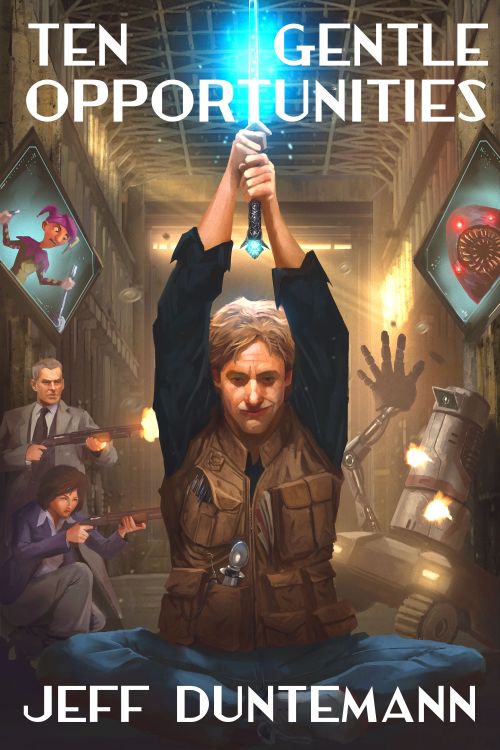I’ve been promising to do a trade paperback edition of Ten Gentle Opportunities for over a year now. Printed books are always good to have around for promo purposes, but I’ve gotten eight or ten explicit requests for paperbacks since the ebook edition was first released in January 2016. Why disappoint customers?
Buy Ten Gentle Opportunities from the CreateSpace store.
Buy Ten Gentle Opportunities from the Amazon store.
Sorry it took so long, guys.
Anyway. Why two sales links? It’s yet another peculiar kink in the increasingly kink-y world of independent publishing. Simply put: I make significantly more money per sale on books ordered from the CreateSpace store than from the conventional Amazon store. I’ll lay it out for you, though you can calculate it yourself using the CreateSpace royalty calculator, with a detailed explanation of how it all works on their Understanding Royalties page.
The book’s specs are these:
- Black and white interior
- 6″ X 9″ trim size
- 310 pages
- $12.95 Cover price
Basically, my share of the book’s cover price is the cover price minus the portion that CreateSpace takes. Their share is the sum of three things:
- The sales channel percentage
- A fixed per-book charge
- A per-page charge
The sales channel percentage is basically the retailer’s discount. There are four sales channels available through CreateSpace, each with an associated discount:
- Amazon US: 40% of cover price
- Amazon Europe: 40% of cover price
- The CreateSpace store: 20% of cover price
- Expanded distribution: 60% of cover price
Expanded distribution is basically retail wholesaling to B&M stores and libraries through distributors like Ingram, Baker & Taylor, and NACSCORP. As you can see, orders coming in from Amazon take twice the amount off the top as orders coming in from the CreateSpace store. I get so little from each expanded distribution sale that I decided not to both with expanded distribution. Sure, it would be cool to see the book on the shelves at bookstores…but the chances of that happening at all are pretty slight.
The fixed per-book charge is a sort of minimum charge for manufacturing the book. For b/w books having 110-828 pages, the fixed charge is $0.85 per book.
The per-page charge is the rest of the manufacturing cost, and depends on page count and whether the interior is b/w or color. For a b/w book in the 110-828 page count range, this charge is $.012 per page; i.e., 1.2 cents per page.
Turning the crank, it comes out like this:
- $12.95 X 20% = $2.59, calculation of channel discount
- $12.95 – $2.59 = $10.36, cover price minus channel discount
- $10.36 – $0.85 = $9.51, minus per-book fixed charge
- 310 pages X $0.012 = $3.72, calculation of per-page charge
- $9.51 – $3.72 = $5.79
My share of each sale through the CreateSpace store is $5.72. For a sales through the Amazon store, the channel charge is 40%, or $5.18. With all else being the same, my share would be $12.95 – $5.18 – $0.85 – $3.72 = $3.20. So by ordering through the CreateSpace store, I get $5.72 rather than $3.20.
However….there is a significant gotcha: You have to set up an account with the CreateSpace store. Also, Amazon Prime shipping does not apply to CreateSpace sales. I recognize that these may be show-stoppers for some people. That’s ok; I won’t be annoyed if you order from the Amazon store.
Mostly, I wrote this entry to provide a little insight as to how authors are paid for paperback editions of books offered through CreateSpace. Because I don’t expect to sell a great many copies of the paperback, it’s a matter of no great importance. Like it or not, we’re hurtling toward an ebook future at most of the speed of light. The ebook is $2.99 and it’s delivered Right Damned Now rather than sometime next week. The ebook is selling well (considering I haven’t been pushing it much) and I’m happy with the money I’m making. Even $3.20 per copy is about par for royalties I’ve received on traditionally published technical books, and this is fiction.
If you still like printed books, I’d be honored if you’d buy a copy. And on that note, I’m going back to writing my latest novel. There are worse ways to be retired than this!













One of the advantages of printed books is that they can be signed. I assume (hope) that you would be willing to sign books sent to you with suitable return postage?
If so, please email me your mailing address. If this is not a good time, just reply here.